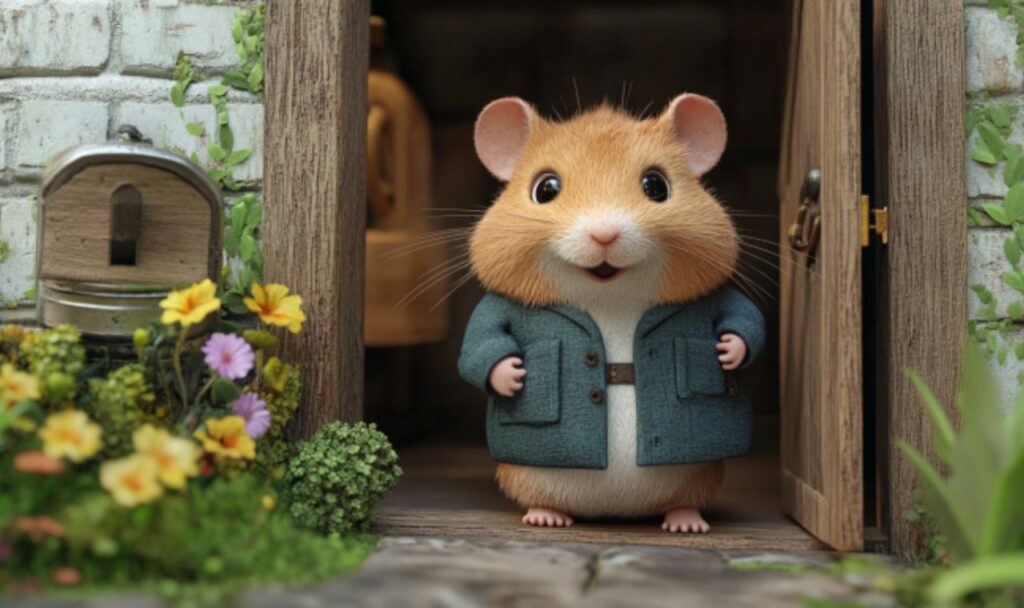Vet visits are an essential aspect of pet care that often come with their own set of challenges, especially for the smallest members of our families—our hamsters. While the significance of these visits for maintaining your hamster’s health cannot be understated, the stress and anxiety associated with them can be a hurdle for both pet and owner. However, fear not! With the right approach and a bit of training, you can make these trips less daunting and more comfortable for your furry companion.
The Importance of Regular Vet Check-ups
Regular vet visits are crucial for your hamster’s health and longevity. They offer the perfect opportunity for professional health assessments, necessary vaccinations, and early detection of any potential health issues. Just like humans, preventative care for hamsters can catch small problems before they turn into larger ones, ensuring your hamster stays happy and healthy for as long as possible.
The Challenge of Stressful Vet Visits
Many hamster owners share a common concern: the stress and discomfort their pets experience during vet visits. The journey to the vet, coupled with a new environment full of unfamiliar sights, sounds, and smells, can be overwhelming for your little friend. This stress isn’t just an immediate concern; it can have lasting effects on their well-being.
Introducing the concept of training your hamster to be comfortable with vet visits not only promises a smoother experience but also contributes significantly to their overall health and happiness. By gradually acclimating your hamster to the sensations and procedures associated with vet visits, you can transform a potentially stressful ordeal into a manageable and routine part of their care. This preparation not only aids in reducing your hamster’s anxiety but also makes the process more streamlined and less worrisome for you as an owner.
Understanding Your Hamster’s Needs

Ensuring your hamster’s well-being involves more than just providing food and a clean cage. It’s about recognizing their emotional needs, understanding the signs of stress, and creating a comforting environment that makes them feel safe and secure. This foundation of trust and comfort is especially crucial when preparing your hamster for potentially stressful experiences, such as vet visits.
Recognizing Stress Signals
Hamsters, though small, communicate distress through various behaviors and physical signs. Identifying these early on is crucial in mitigating stress and preventing it from escalating into health issues. Here are some common stress signals in hamsters:
- Increased Aggression or Hiding: A hamster that is suddenly more aggressive or hides more than usual could be feeling threatened or stressed.
- Changes in Eating or Grooming Habits: A stressed hamster might eat less or start over-grooming, leading to bald patches.
- Pacing or Circling: Repetitive movements, such as pacing or circling within their cage, can indicate stress or boredom.
- Freezing: Hamsters might freeze in place when they’re scared, which is a natural defense mechanism.
Understanding these signals allows you to adjust your approach, ensuring your hamster feels safe and reducing their stress levels effectively.
The Basics of Comfort
Creating a comfortable environment for your hamster encompasses several key factors:
- Familiar Scents: Hamsters rely heavily on their sense of smell to recognize their surroundings. Keeping a piece of bedding or a toy inside their travel carrier can help comfort them with a familiar scent during vet visits.
- Quiet Environments: Hamsters are sensitive to noise. A quiet, calm environment can significantly reduce their stress. When visiting the vet, try to keep their carrier covered with a light cloth to muffle unfamiliar sounds.
- Safe Space: Ensure your hamster has a safe space within their cage and carrier. This could be a small hideout or a nest of bedding where they can retreat when they feel overwhelmed.
By addressing these basic needs, you’re not just making your hamster comfortable; you’re communicating that they’re in a safe, secure place, which is vital for their overall well-being.
Building Trust with Your Hamster
Establishing a bond with your hamster is foundational to making them more receptive to training and handling. Here are some tips to build this trust:
- Gentle Handling: Start by letting your hamster get used to your presence. Offer treats from your hand and speak softly to them. Gradually progress to gentle handling, always being mindful of their comfort level.
- Consistent Interaction: Regular, positive interactions can help your hamster associate you with safety and comfort. Consistency is key; even short daily sessions can significantly impact their trust in you.
- Patience and Positive Reinforcement: Use treats and gentle petting as rewards for calm behavior. Avoid punishing your hamster, as this can erode trust and increase stress.
Building a strong bond with your hamster not only enriches your relationship but also lays the groundwork for successfully training them to handle vet visits with ease. It’s a process that requires patience, understanding, and empathy, but the reward—a happy, healthy hamster comfortable with their care routine—is well worth the effort.
Step-by-Step Guide to Vet Visit Training

Preparing your hamster for vet visits involves more than just the day-of logistics. It’s about gradually acclimating them to the various aspects of the experience, from being comfortable in a travel carrier to staying calm during the exam. Here’s how you can make vet visits a stress-free experience for your furry friend.
Familiarization with the Carrier
The travel carrier is your hamster’s first introduction to their vet visit journey. Making this space safe and inviting is crucial for a positive experience.
- Choose the Right Carrier: Opt for a carrier that’s sturdy, well-ventilated, and spacious enough for your hamster to move around comfortably. Ensure it’s secure to prevent escapes.
- Introduce the Carrier Early: Place the carrier in your hamster’s environment several days before the vet visit. Leave the door open and place treats inside to encourage exploration.
- Add Comforting Elements: Include familiar bedding, a favorite toy, or a piece of cloth with their scent (or yours) inside the carrier. These familiar items can help soothe your hamster during travel.
- Practice Short Trips: Take your hamster on short, non-stressful trips around your home or neighborhood to get them used to being in the carrier. Gradually increase the duration as they become more comfortable.
Desensitization to Movement and Noise
The sounds and sensations of travel can be unsettling for hamsters. Gradual desensitization can help them become more comfortable with these aspects of the vet visit.
- Start with Sound: Play recordings of traffic or car sounds at a low volume near your hamster’s habitat. Gradually increase the volume over several days, always monitoring your hamster’s reaction to ensure they’re not stressed.
- Simulate Travel Movements: While your hamster is in the carrier, gently simulate the movements they might experience during travel—such as starting, stopping, and turning. Keep these sessions short and positive, using treats as rewards.
- Create Positive Associations: Pair the sounds and movements of travel with positive experiences. Offer treats and gentle petting to help your hamster associate these previously unsettling stimuli with safety and comfort.
Handling Practice
Vet visits require your hamster to be handled by someone other than you. Preparing them for this through handling practice can make the actual experience less stressful.
- Gradual Introduction to Handling: If your hamster isn’t already comfortable with being held, start by letting them crawl onto your hand for treats. Progress to gently lifting them for short periods, gradually increasing the time as they become more comfortable.
- Simulate a Vet Exam: Gently examine your hamster as a vet might. This includes lightly holding them, checking their belly, and gently opening their mouth. Reward calm behavior with treats and praise.
- Use a Towel or Glove: Vets might use a towel or wear gloves to handle your hamster. Familiarize your hamster with these items by gently wrapping them in a towel or letting them explore while you wear gloves, making sure these experiences are positive.
By taking these steps, you’re not just preparing your hamster for vet visits; you’re ensuring their health and happiness through positive, stress-free experiences. Remember, the key to successful vet visit training lies in patience, persistence, and lots of love.
Creating a Positive Vet Visit Experience

A positive vet visit experience for your hamster starts with preparation and ends with proper post-visit care. Each step of the process is an opportunity to minimize stress and ensure your hamster’s health and well-being are supported throughout. Here’s how to make vet visits a more positive experience for your furry friend.
The Day Before the Visit
Preparation is key to reducing stress for both you and your hamster. Here’s what you can do the day before the visit:
- Prepare the Carrier: Make sure the carrier is clean, comfortable, and equipped with familiar items from your hamster’s cage. A favorite toy, bedding, or a piece of cloth with home scents can provide comfort and security.
- Pack a Hamster Kit: Include essentials like water, a water bottle or dish, extra bedding, and a few treats. If the visit might be long, bring a small amount of their regular food.
- Keep Your Hamster Calm: Maintain your regular routine to avoid causing any additional stress. Offer extra cuddles or playtime to help your hamster feel secure and loved.
During the Visit
The visit itself can be the most stressful part of the process, but there are ways to keep your hamster calm:
- Transport Safely: Keep the carrier secure in your vehicle, away from direct sunlight or drafts. Covering the carrier with a light cloth can also help reduce visual stressors.
- Wait in a Quiet Area: If possible, wait in a quiet area away from dogs, cats, and other predators that could frighten your hamster. Some vet offices may have a separate waiting area for small animals.
- Communicate with Your Vet: Let the vet know about any specific concerns or behaviors they should be aware of. If you’ve been practicing handling at home, explain what techniques have been most effective in keeping your hamster calm.
- Stay Calm Yourself: Hamsters can pick up on your emotions. Staying calm and speaking softly can help reassure your hamster that they are safe.
Post-Visit Care
After the visit, it’s important to help your hamster recover from the stress and adjust back to their normal routine:
- Quiet Time: Once home, place your hamster back in their cage and give them some quiet time to adjust. Avoid the temptation to check on them too frequently, which can add to their stress.
- Monitor Eating and Drinking: Ensure your hamster resumes eating and drinking normally. A treat they enjoy can be a good way to encourage them to start eating again.
- Check for Signs of Stress: Over the next few days, keep an eye out for any signs of stress or illness, such as changes in behavior, appetite, or activity levels. If you notice anything concerning, don’t hesitate to contact your vet.
- Offer Extra Comfort: Continue to provide a comfortable environment with plenty of nesting material and hiding places. Gentle interaction and handling can also help reassure your hamster that everything is okay.
Creating a positive vet visit experience for your hamster involves thoughtful preparation, gentle care during the visit, and attentive post-visit monitoring. By taking these steps, you can make vet visits a less stressful and more manageable part of your hamster’s care routine, ensuring they remain healthy and happy.
Hannah’s Training Tactics

Making vet visits a less stressful experience for your hamster is all about preparation, patience, and a little bit of creativity. Here are some quick, actionable tips that can help ease the process for both you and your furry friend, including a DIY “comfort kit” for vet visits. These tactics are designed to be simple yet effective, ensuring your hamster feels safe and secure throughout their journey.
Quick Tips for Stress-Free Vet Visits
- Practice Makes Perfect: Regularly use the carrier at home as a cozy resting place, not just for vet visits, so your hamster associates it with safety and comfort.
- Snack Time: Bring along their favorite treats. Offering a treat before, during (if possible), and after the visit can help create positive associations with the vet experience.
- Speak Softly: Use a calm, soothing voice when interacting with your hamster during the preparation, travel, and waiting at the vet’s office. Your voice can be a powerful tool in keeping them relaxed.
- Familiar Faces: If possible, visit the same vet each time so your hamster can become familiar with them. Familiarity breeds comfort, reducing stress with each visit.
- Cover for Calm: Keep the carrier covered with a breathable cloth during transport and waiting times to help block out stressful sights and sounds.
DIY “Comfort Kit” for Vet Visits
Creating a comfort kit for your hamster’s vet visits is a great way to ensure you have everything needed to keep them calm and comfortable. Here’s how to assemble your kit:
Materials Needed:
- A small, soft blanket or towel for bedding.
- A favorite toy or a piece of chewable wood to gnaw on.
- A small, portable hideout or tunnel that fits inside the carrier.
- Treats that your hamster loves.
- A small, spill-proof water bottle or dish.
- A list of your hamster’s usual diet and any medical history for the vet.
Assembly Instructions:
- Choose a Small Bag: All items should fit into a small, easily transportable bag that you can grab along with the carrier.
- Pack Comfort Items: Place the blanket or towel at the bottom of the bag. Add the toy or chewable item and the portable hideout.
- Prepare the Treats: Pack a small container of your hamster’s favorite treats. These can be used to coax them into the carrier and comfort them during the visit.
- Water on the Go: Include a small water bottle or dish. Hydration is key, especially if the trip is longer or on a hot day.
- Vet Info: Keep a note with your hamster’s dietary information and any medical history in the bag. This is especially helpful if you’re seeing a new vet or in case of an emergency.
This DIY “comfort kit” can make vet visits significantly more manageable, ensuring that you’re always prepared to meet your hamster’s needs and keep them as stress-free as possible. With these simple yet effective tactics, you’re well on your way to mastering the art of stress-free vet visits for your hamster.
Conclusion

Navigating the journey of pet ownership is filled with moments of joy, challenges, and invaluable learning experiences. Among these, ensuring the health and well-being of our tiny companions through regular vet visits stands out as a cornerstone of responsible pet care. However, the stress associated with these visits can often overshadow their importance, both for hamsters and their owners. Recognizing this, we’ve delved into strategies and practices aimed at transforming vet visits from a source of anxiety into a manageable, if not entirely stress-free, experience.
The key to achieving this lies in understanding and addressing the unique needs of our hamster friends. From recognizing signs of stress to creating a comforting environment and building a foundation of trust, each step paves the way for a smoother vet visit. The step-by-step guide to vet visit training, including familiarization with the carrier, desensitization to movement and noise, and handling practice, offers a structured approach to preparing your hamster for their health checks. Moreover, the concept of a DIY “comfort kit” for vet visits embodies the essence of thoughtful preparation, ensuring that every aspect of the experience is tailored to minimize stress and enhance comfort.
As we conclude this guide, it’s important to remember that patience and consistency are your best allies in this endeavor. The journey to making vet visits a positive experience for your hamster may require time and effort, but the outcomes—seeing your hamster navigate these visits with ease and maintaining their health and happiness—are well worth it. Each small step taken today lays the groundwork for a lifetime of care and companionship.
So, to all the hamster owners embarking on this journey, remember: the path to becoming a Hamster Whisperer is paved with paws and patience. Stay consistent in your training efforts, keep your heart open to learning, and cherish the bond that grows stronger with each challenge you overcome together.
“With paws and patience, you’re on the road to being a Hamster Whisperer. Happy training!”




